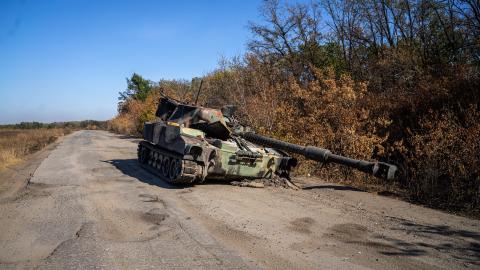Below Senior Fellow Can Kasapoğlu offers a military situation report about the war in Ukraine.
Executive Summary
• Russian forces captured the Ukrainian town of Vuhledar.
• Innovations in drone warfare continued to shape the battlefield.
• The Netherlands delivered the first of a reported 24 F-16 aircraft to Ukraine.
• Ukraine identified a list of potential high-value targets inside Russia that it would strike if given permission from its Western allies.
1. Battlefield Assessment
As previous editions of this report foresaw, the critical transport hub of Vuhledar fell to the Russian military last week despite a resilient defensive effort. Ukrainian troops had used the heavily armed and well-fortified town as a garrison to protect the southern axis of the city of Pokrovsk, only 31 miles away.
High-ranking Russian operational commanders have arrived in the newly seized town. The Kremlin will likely seek to capitalize on its success and push the heavily taxed units that took Vuhledar to their limits to maximize territorial gains.
Accordingly, Moscow has reportedly amassed additional troops on the nearby Kurakhove front, and Russian combat formations have begun to push into the villages of Prechystivka and Zolota Nyva. Success there could expose the town of Velyka Novosilka, which Russia’s invasion planners have long coveted.
Pokrovsk, Chasiv Yar, and Toretsk also saw heavy fighting last week, and Russian forces suffered considerable casualties. According to declassified intelligence reports from the United Kingdom’s Defence Intelligence, Russia lost an average of 1,270 fighters per day in September.
Moscow and Kyiv continued to wage tactical offensives in the Russian region of Kursk, where Russian airborne troops contended with Ukrainian artillery and first-person-view (FPV) drones. Nonetheless, available information does not suggest that any large-scale territorial changes or shifts in battlefield geometry in the region are imminent.
Clashes erupted in southern Ukraine along the Dnipro River and near the village of Robotyne. In the country’s north, Kharkiv saw mounting skirmishes but remained strategically stable. Ukrainian press sources reported that Kyiv’s elite 3rd Mechanized Brigade recently recaptured lost positions and freed several Ukrainian prisoners of war.
2. Drone Warfare Developments Continue to Shape the Battlefield
New developments in robotic warfare continued to affect how the war in Ukraine is being waged.
The Ukrainian Armed Forces released a video of its new “dragon drone” dropping thermite charges onto Russian heavy armor. The footage depicted the drone, operated by the 30th Mechanized Brigade, destroying a Russian main battle tank on flat terrain. Additionally, anti-Kremlin Chechen forces fighting alongside the Ukrainian military seek to develop an aerial drone dubbed Stiglara Tajzar, or heavenly wrath. The Chechens plan to crowdfund the drone’s development and advertise online to find operators and instructors. Ukraine’s Sea Baby naval drones, equipped with multiple-launch rocket systems, were also filmed unleashing salvos at Russian positions on shore last week.
These developments highlight how drone-on-drone warfare continues to dominate the battlespace in Ukraine. In many engagements, aerial drones have downed other uncrewed platforms. In other incidents, Ukrainian FPV detachments have preyed on Russian unmanned ground vehicles (UGVs). To minimize the threat from Ukrainian drones, Russia has equipped its robotic land warfare systems with protective roof screens. Russian defense companies showcased their rapid UGV developments at several recent defense exhibitions. Meanwhile, Ukraine conducted UGV operations in the Russian region of Kursk.
Finally, available assessments suggest that on October 6 in the skies over Chasiv Yar, the Russian Aerospace Forces (VKS) shot down one of its own Okhotnik stealth drones to prevent the system from falling into Ukrainian hands. A joint venture between the Sukhoi and MiG defense giants, the Okhotnik drone is designed to someday operate alongside the manned Su-57 combat aircraft. Western military assessments suggest that the drone possesses high-end artificial intelligence capabilities. It is not clear whether Ukraine jammed the platform before it was shot down.
3. Ukraine’s Political Fight to Improve Its Long-Range Strike Deterrent
Press reports suggest that the Ukrainian military has identified 261 targets inside Russia that it could strike if Western nations allow Kyiv to use long-range weaponry beyond its borders. The target set reportedly includes military bases and ammunition depots.
Rear areas have been critical vulnerabilities for the Kremlin’s combat formations since the outset of the war. Ukraine’s Army Tactical Missile System (ATACMS), if equipped with the proper warhead configuration, could prove highly effective against high-value targets inside Russia.
Meanwhile, the Ministry of Defense of the Netherlands announced that it delivered its first F-16 aircraft to the Ukrainian Air Force. Overall, the Netherlands plans to donate 24 combat aircraft to Ukraine and initiate a $439 million program to develop combat drones in collaboration with Kyiv.




















